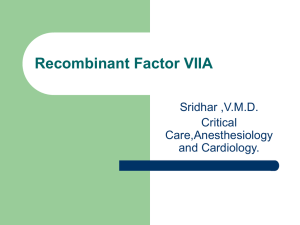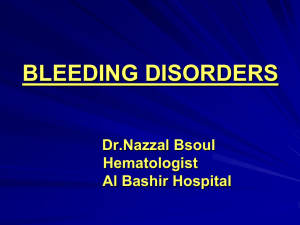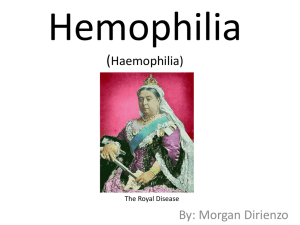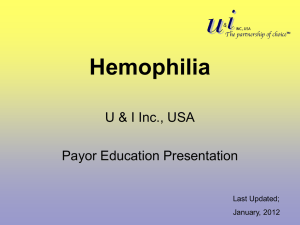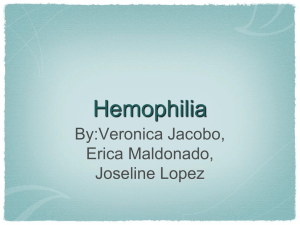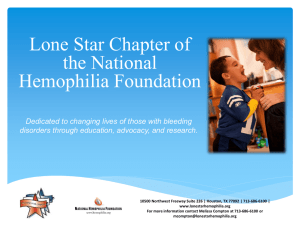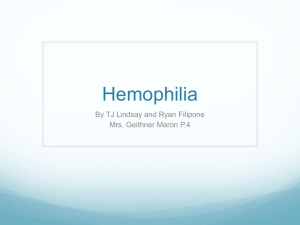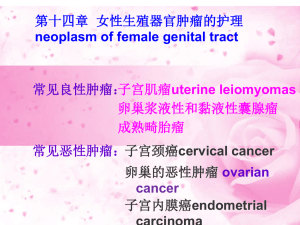haemophilia final
advertisement
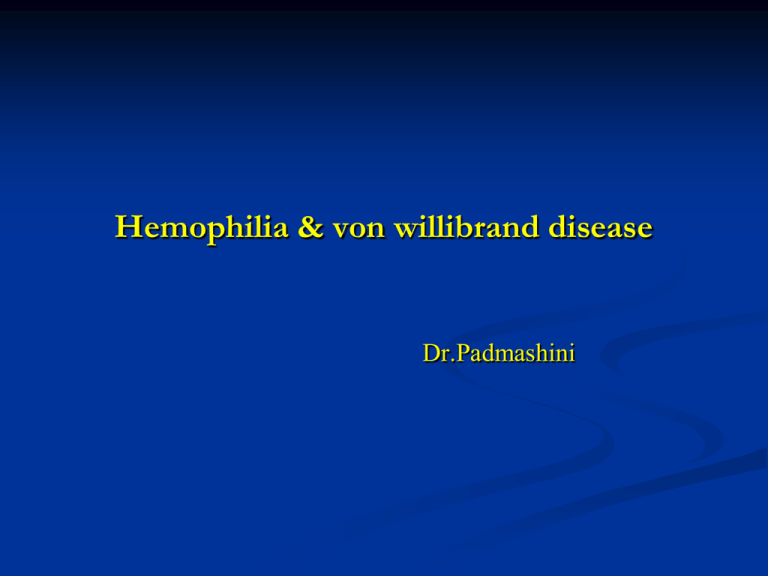
Hemophilia & von willibrand disease Dr.Padmashini objectives History Introduction Definition Clinical Features Diagnosis Available treatment modalities History Best known of the hereditary bleeding disorders. First coined by Schonlein in 1820s. Originally termed “Haemorraphilia” i.e. love for haemorrhages but over time contracted to Hemophilia. Hemophilia is often called the disease of kings because it was carried by many members of Europe’s royal family. Queen Victoria of England was a carrier of hemophilia Introduction Hemophilia are bleeding disorders due to deficiency or defect in one of the factor present in clotting cascade, X – linked recessive disorder, Disease of men with women being asymtomatic carrier Definition Hemophilia A (classic) : deficiency or dysfunction of factor VIII It is a large single chain protein that regulates the activation of factor X by proteases generated in intrinsic coagulation pathway Incidence : 1 in 10,000males Hemophilia B (Christmas) : deficiency or dysfunction of factor IX Incidence : 1 in 25,000-35,000 males Von willibrand disease : It is a hereditary deficiency a defect in portion of factor VIII complex Types Factor level < 1% - severe disease Factor level 1-5% - moderate disease Factor level 5-20 % - mild disease Factor level 20-50% - unaware that they have hemophilia Clinical features Easy bruising & recurrent bleeding in to joints & muscles Bleeding occurs hrs or days after injury if untreated continue for days or weeks Large collection of clotted blood putting pressure on adjacent normal tissuenecrosis of muscle – compartment syndrome Pseudophlebitis : venous congestion Pseudotumour : bone cysts result from unresolved hematoma CNS : SDH occur spontaneously or with minimal trauma Hematuria : common usually not serious Femoral neuropathy due to pressure from unsuspected retroperitoneal hematoma Mucocutaneous bleeding: spontaneous bleeding in to orophraynx , GI tract, epistaxsis ,hemoptysis, delayed bleeding after dental extraction Hemophilic Arthropathy: chronic inflammation. Chronic proliferative synovitis characterised by progressive and erosive destruction of joint cartilage, narrowing of joint space scenario A one yr old male baby brought to ER at around 4 pm with bleeding continously after a small cut in the knee joint while playing at around 11am on the same day Lab Investigation COAGULATION PROFILE PT – normal aPTT – prolonged Factor assay factor VIII deficiency – hemophilia A factor IX deficiency – hemophilia B Bleeding time - normal Prenatal diagnosis Obtain chorionic villi samples in 10th-11th gestational week and perform direct genotype testing. Initial assesment Early & complete factor replacement before or at the same time as other resuscitative & diagnostic maneuvers Bleeding in to neck,tongue,retropharynx – airway compromise – intubation Bleeding in to CNS – immediate factor replacement fallowed by CT scan Cont.. Neurologic defecit localize to region with in spinal cord – MRI Hemophilic pt with back, thigh, groin, abdominal pain-factor replacement with imaging Hemarthrosis – consult orthopedist for splinting & rehabilitation Special attention Adequate pain relief with opiods Avoid aspirin & NSAID DONTS Central lines should not be placed with out factor replacement ABG/ arterial line IM injections Treatment Factor replacement therapy Two different options : Plasma derived & purified factor Recombinant factor replacement Hemophilia A Human plasma derived factor VIII products Human plasma derived factor VII Recombinant factor VIII products Porcine factor VIII products Hemophilia B Factor IX complex product Activated factor IX complex product Purified factor IX product Recombinant factor IX product DOSAGE Dosing regimen based on clotting factor volume of distribution, half life of factor & hemostatic level of factor required to control the bleeding Hemophilia A One unit of factor VIII per Kg of body weight raises plasma level by approximately0.02U/ml Half life – 8-12 hrs Dose of FVIII (units) = (percent desired rise in plasma FVIII) x (body wt) x 0.5 Hemophilia B One unit of factor IX per Kg of body weight raise the plasma level by0.01u/ml Half life – 16 hrs Dose of factor IX(units)=(percent desired rise in factor IX) X body weight FACTOR REPLACEMENT GUIDELINES Minimum initial factor levels 40-50% 80-100% 50% 100% 30-50% 100% Undiagnosed bleeding disorder FFP or cryoprecipitate Each bag cryoprecipitate: 100 units of factor VIII FFP – all plasma clotting factor ,concentration of 1u/ml One unit FFP – raise factor level 3-5 % Cryoprecipitate Prepared by slowly thawing fresh frozen plasma at 2-4`C, then harvesting the precipitate by centrifugation. Cryo prepared from 200ml of FFP contains 80-100 U of FVIII, ~250mg fibrinogen and useful amounts of FXIII and vWF per 10-15ml of precipitate. Use thawed cryo within 4hr. Can be stored at -18`C for 1yr. scenario A 10 yr old girl weighing 20kg a known case of haemophilia B came to ER with complaints of profuse gum bleeding after brushing her teeth Specific problems Oral & mucosal bleeding : Area identified, cleaned of inadequate clot & dry topical thrombin placed at bleeding site Factor replacement should be 80-100 % Antifibrinolytic agent( epsolin aminocarporic acid & tranexamic acid) Dose of EACA – 75-100 mg/kg q 6 h (children) 1-6 g q 6 h for adults Given PO /IV Tranexamic acid oral- 25 mg/kg/dose every 6-8hr. iv - 10 mg/kg/dose every 6-8hr Topical hemostatic agent – microfibrillar collagen hemostat,thrombin & absorbable gelatin sponges scenario A 25 yr old gentleman who is diagnosed as having haemophilic A 10 yrs ago, with factor level of 25% admited in the hospital for severe AGE,while securing I.V cannula pt had continous bleeding from the vene puncture site Mild hemophilia A Treated with desmopressin Desmopressin cause release of Vwf from endothelial site Inc amount of Vwf capable of carrying additional amount of factor VIII in plasma Dose Intravenous: 0.3 ug/kg ( max 20 ug) over 30 min Intra nasal : children > 5 yrs single spray in single nostril (150 ug total dose) Adults & adolescent 300 ug total dose Third dose – inc factor by 2-3 times Repeated 8-12 hrs Pts stores of factor VIII will be depleted & subsequently effect will be less Scenario A 7yr old boy who is an haemophilic came to ER with complains of tooth ache O/E pt was having caries tooth,for which dentist has adviced tooth extraction Dental procedure Filling carries tooth : single infusion of factor VIII with administration of 4-6 g of EACA q6h for 3-4 days Major oral & periodontal surgery , extraction of permanent teeth – factor replacement begin before surgery & continue for 2-3 days Inhibitors Usually IgG antibodies that rapidly neutralize factor VIII activity Two types : Type 1 – raise their antibody fallowing exposure to factor VIII Type 2 – low antibody titre not stimulated by factor VIII infusion Type 1 – should not receive factor VIII Control of bleeding – porcine factor VIII -prothrombin complex concentrate Type 2 – respond to higher doses of factor VIII Gene therapy –Involves transfer of genes that express a particular gene product into human cells studies in human under trial Complication Multiple episodes of hepatitis Elevated hepatocellular enzyme level Hepatospleenomegaly End stage liver disease Iv drug abusers & long term hemophilia – high risk for AIDS Von willibrand disease It is a hereditary deficiency a defect in portion of factor VIII complex vWF is a glycoprotien ,synthesized, stored & then secreted by vascular endothelial cells Co factor for platelet adhesion & carrier protien for factor VIII Major three groups Type 1 : common & partial quantitiative disease Type 2 : qualitative ( abnormal function) Type 3 : severe & almost compelete defeciency of vWF Clinical features Skin & mucosal bleeding Recurrent epistaxsis,gingival bleeding Unusual bruising GI bleeding Menorrhagia in young women Laboratory test Prolonged bleeding time Low or normal vWF antigen Low vWF activity Mildly prolonged aPTT Pt with O bld group – 30 % reduction in vWF level compared to other bld groups Treatment Non transfusional therapy : Desmopressin – mainstay of treatment with type 1 vWF It induces release of vWF from storage site with in the endothelium Dose Transfusional therapies Plasma derivatives Cryoprecipitate Humate p Platlelet transfusion Prevention of bleeding Avoid trauma by adjusting their lifestyle. Contact sports should be avoided, but swimming and cycling with appropriate gear should be encouraged. Avoid use of drugs that affect platelet function viz. NSAIDs. What medical information should be carried by a hemophiliac ? A person with hemophilia should carry information about his health, including the type of hemophilia, treatment needed, and allergies. An international medical card is available free through the World Federation of Hemophilia. Tags called Medic-Alert and Talisman are sold in some countries World Hemophilia Day 2009 Since 1989, patient groups and treatment centres have been coming together on April 17 to celebrate World Hemophilia Day. The theme for World Hemophilia Day 2009 is “Together, we care,” which emphasizes the importance of comprehensive care in hemophilia healthcare delivery. Take home message Early & complete factor replacement Do not waste time in imaging studies Prevention of bleeding The Sun is Rising for Patients with Hemophilia The Future is Bright Thank you


